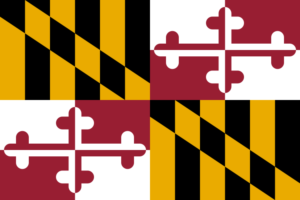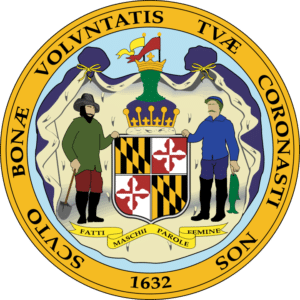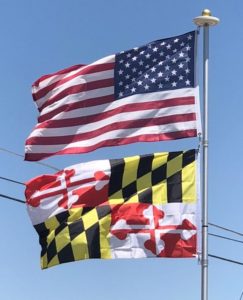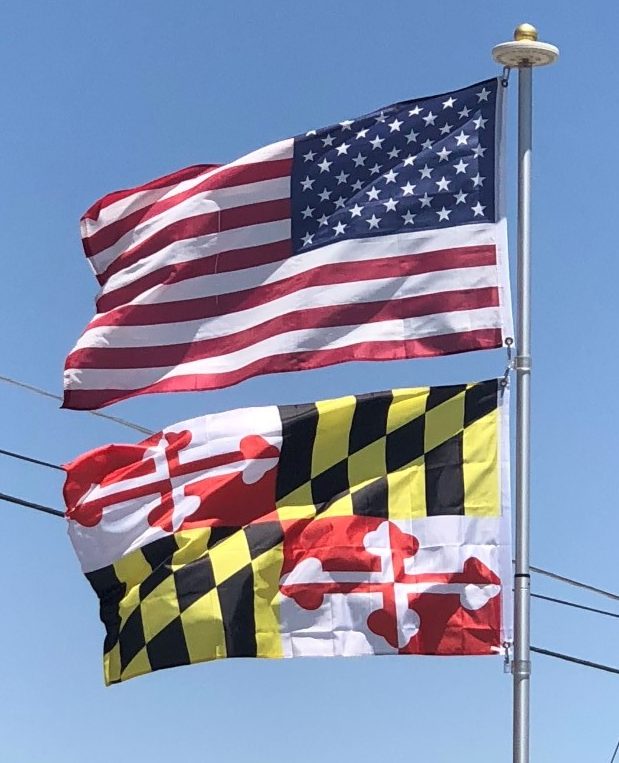
The flag was officially adopted by the Maryland General Assembly in 1904. The first Maryland flag design consisted of the seal of Maryland on a blue background.

The black and gold design on the flag is the coat of arms from the Calvert line. It was granted to George Calvert as a reward for his storming a fortification during a battle. The red and white design is the coat of arms of the Crossland line, the family of Lord Baltimore’s mother, and features a cross bottony with the red and white sides of the cross alternating. Since George Calvert’s mother was an heiress, he was entitled to use both coats of arms in his banner. The Maryland flag is the only US state flag to be directly based on English heraldry.
During the colonial period, only the gold and black Calvert arms were associated with Maryland. The state stopped using the colors following independence, but they were reintroduced in 1854.
The red and white colored arms of the Crossland family, which belonged to the family of Calvert’s (Lord Baltimore’s) paternal grandmother, gained popularity during the American Civil War, during which Maryland remained with the Union despite a large proportion of the citizenry’s support for the Confederacy, especially in the central city of Baltimore and the counties of the southern part of the state and the Eastern Shore of the Chesapeake Bay. Those Marylanders who supported the Confederacy, many of whom fought in the Army of Northern Virginia of General Robert E. Lee, adopted the Crossland banner.
Likewise, the black and gold (yellow) colors with the chevron design of the Calvert family were used in the flags and devices and uniform pins of the Union Army regiments in the northern Army of the Potomac. After the war, Marylanders who had fought on either side of the conflict returned to their state in need of reconciliation. The present design, which incorporates both of the coats of arms used by George Calvert, began appearing as a consequence of this desire for unity.
Section 7-202 of the General Provisions Article of the Annotated Code of Maryland provides: “(a) The State flag is divided into quarters. (b) The first and fourth quarters are a paly of six pieces, or (gold) and sable (black), and a bend dexter (right diagonal band) counterchanged, so that they consist of six alternating gold and black vertical bars with a diagonal band on which the colors are reversed. (c) The second and third quarters are quartered argent (white) and gules (red), a cross bottony counterchanged, so that they consist of a quartered field of white and red, charged with a Greek cross that has arms terminating in trefoils and opposite coloring so that red is on the white quarters and white is on the red quarters, as represented on the escutcheon of the State seal.”

Maryland is the only state in the union that has a specific guideline not only on how to display the flag but on what the flagpole should look like as well. In 1945, the Maryland General Assembly made a gold cross bottony the official ornament for the top of any flagpole carrying the state flag. Some time before October 10, 2007, Government House (the governor’s mansion) in Annapolis ceased to display the cross bottony at the top of the flag pole, but the flags at the State House continue to do so (adhering to Maryland General Provisions Code § 7-202 & 7-203 (2016)). All other state government buildings, including public schools, obey this guideline, but many private individuals and businesses do not.
